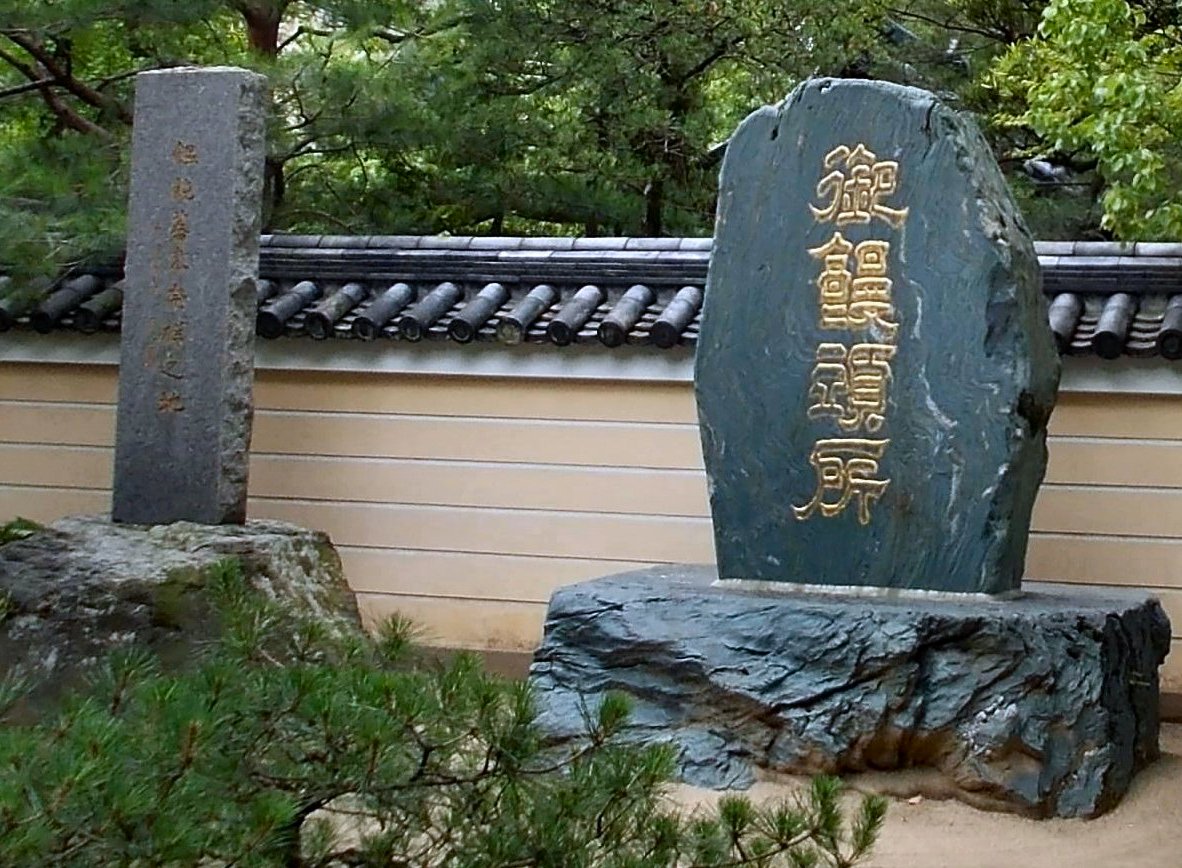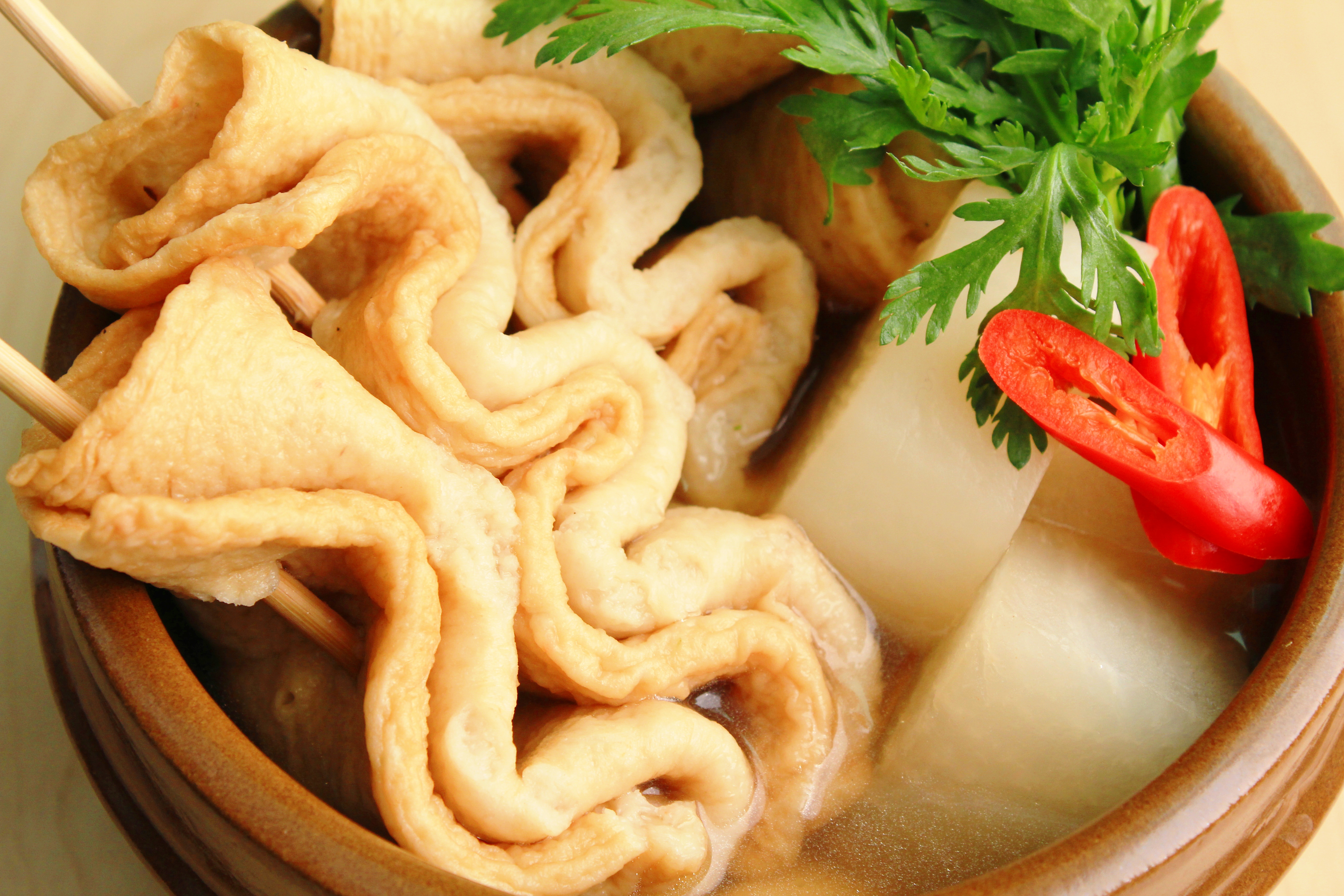|
Ganmodoki
is a fried tofu fritter made with vegetables, such as carrots, lotus roots and burdock. It may also contain egg. ''Ganmodoki'' means ''pseudo-goose'' ( + ). This is because ganmodoki is said to taste like goose; compare mock turtle soup. ''Ganmodoki'' is also called ''ganmo'' for short. In the Edo period, ''ganmodoki'' was a stir-fried konjac dish. A dish similar to the ganmodoki today was made by wrapping chopped up vegetables in tofu (much like a manjū) and deep frying it. In Western Japan, Ganmodoki is called ''hiryōzu'', ''hiryuzu'' or ''hirōsu'', from the Japanese words of Portuguese origin, Portuguese word ''filhós'' or Spanish ''fillos (dish), fillos''. Gallery File:Ganmodoki 1 by kina3.jpg, Ganmodoki (right) See also * Oden * List of tofu dishes * References External links ganmodoki-or-hiryouzu-japanese-tofu-fritters {{Japan-cuisine-stub Deep fried foods of Japan Tofu dishes ... [...More Info...] [...Related Items...] OR: [Wikipedia] [Google] [Baidu] |
Tofu
or bean curd is a food prepared by Coagulation (milk), coagulating soy milk and then pressing the resulting curds into solid white blocks of varying softness: ''silken'', ''soft'', ''firm'', and ''extra (or super) firm''. It originated in China and has been consumed in the country for over 2,000 years. Tofu is a traditional component of many East Asian cuisine, East Asian and Southeast Asian cuisine, Southeast Asian cuisines; in modern Western cooking, it is often used as a Meat alternative, meat substitute. Nutritionally, tofu is low in calories, while containing a relatively large amount of protein. It is a high and reliable source of iron, and can have a high calcium or magnesium content depending on the Flocculation, coagulants (e.g. calcium chloride, calcium sulphate, magnesium sulphate) used in manufacturing. Cultivation of tofu, as a protein-rich food source, has one of the lowest needs for land use (1.3 m²/ 1000 kcal) and emits some of the lowest amount of greenhouse ... [...More Info...] [...Related Items...] OR: [Wikipedia] [Google] [Baidu] |
Japanese Words Of Portuguese Origin
Many Japanese words of Portuguese origin entered the Japanese language when Portugal, Portuguese Jesuit priests and traders introduced Christian ideas, Western science, medicine, technology and new products to the Japanese during the Muromachi period (15th and 16th centuries). The Portuguese Empire, Portuguese were the first Europeans to reach Japan and the first to establish direct trade between Japan and Europe, in 1543. During the 16th and 17th century, Portuguese Jesuits had undertaken a great work of Catechism, that ended only with religious persecution in the early Edo period (Tokugawa Shogunate). List of direct loanwords Many of the words which were introduced and entered the Japanese language from Portuguese language, Portuguese and Japanese words of Dutch origin, Dutch are written in ''kanji'' or ''hiragana,'' rather than ''katakana'', which is the more common way to write loanwords in Japanese in modern times. ''Kanji'' versions of the words are ''ateji'', characters tha ... [...More Info...] [...Related Items...] OR: [Wikipedia] [Google] [Baidu] |
Carrot
The carrot ('' Daucus carota'' subsp. ''sativus'') is a root vegetable, typically orange in colour, though heirloom variants including purple, black, red, white, and yellow cultivars exist, all of which are domesticated forms of the wild carrot, ''Daucus carota'', native to Europe and Southwestern Asia. The plant probably originated in Iran and was originally cultivated for its leaves and seeds. The carrot is a biennial plant in the umbellifer family, Apiaceae. World production of carrots (combined with turnips) for 2022 was 42 million tonnes, led by China producing 44% of the total. The characteristic orange colour is from beta-carotene, making carrots a rich source of vitamin A. A myth that carrots help people to see in the dark was spread as propaganda in the Second World War, to account for the ability of British pilots to fight in the dark; the real explanation was the introduction of radar. Etymology The word is first recorded in English around 1530 and w ... [...More Info...] [...Related Items...] OR: [Wikipedia] [Google] [Baidu] |
Manjū
is a traditional Japanese confection, usually a small, dense bun with a sweet filling. They come in many shapes and varieties. The standard manjū has a skin made of flour, and is filled with '' anko'' (sweet azuki bean paste). Some varieties use kudzu starch or buckwheat flour for the skin. Other types of filling include sweet potato, chestnut jam, or custard. Manjū is usually steamed or baked, though fried manjū can be found in some modern restaurants. Traditional manjū are usually round, but many different shapes exist today, and some are proprietary to specific bakeries. History Manju is a traditional Japanese flour-based pastry (instead of rice-based like mochi). During the Kamakura period (1185–1333), Japanese Buddhist monks who studied in the Song dynasty brought the tea culture to Japan, and the custom of eating confections with tea began in Japan. The monks also introduced , a light meal, and the history book mentions , , and as . It is believed that th ... [...More Info...] [...Related Items...] OR: [Wikipedia] [Google] [Baidu] |
List Of Tofu Dishes
This is a list of tofu dishes. Tofu, also called bean curd, is a food made by coagulating soy milk and then pressing the resulting curds into soft white blocks. It is a component in many East Asian and Southeast Asian cuisines. Tofu dishes * * * * * * * * ''Dubu gui'' – grilled tofu rectangles * ''Dubu jjigae'' – Korean tofu stew p. 97. * * * * * * * * * * * * * * ''Tahu aci'' * * * * ''Tahu gimbal'' * * ''Tahu petis'' * * * [...More Info...] [...Related Items...] OR: [Wikipedia] [Google] [Baidu] |
Oden
is a type of nabemono (Japanese one-pot dishes) consisting of several ingredients such as boiled eggs, daikon or konjac, and processed fishcakes stewed in a light, soy-flavored dashi broth. Oden was originally what is now commonly called ' or simply ''dengaku''; konjac (''konnyaku'') or tofu was boiled and eaten with miso. Later, instead of using miso, ingredients were cooked in dashi, and oden became popular. Ingredients vary according to region and between each household. Karashi is often used as a condiment. Oden is often sold from food carts, though some izakayas and several convenience store chains also serve it, and dedicated oden restaurants exist. Many different varieties are sold, with single-ingredient dishes sometimes as cheap as 100 yen. While it is usually considered a winter food, some carts and restaurants offer oden year-round. Many of these restaurants keep their broth as a master stock, replenishing it as it simmers to let the flavor deepen and ... [...More Info...] [...Related Items...] OR: [Wikipedia] [Google] [Baidu] |
Fillos (dish)
Fillos de Galicia is a web portal and virtual community that focuses on the Galician culture and diaspora. The site focuses on promoting unity between Galicians and the Galician diaspora. The community is a hub that provides information about the Galician language or finding relatives in Galicia using the Atopadoiro'. Fillos.org is one of the most popular websites regarding Galicia and its diaspora. History Fillos de Galicia was started in 1997 by Manuel Casal Lodeiro, son of Galician emigrants. Since its inception, the portal has been growing. The supporting association spawned sister sites dealing with specific themes relating to Galicians. Statistics As of 2010, more than 6700 users had registered, from over 70 countries. Most are between ages 30 and 60. Over 1500 live in Argentina, with sizable populations in Spain and Brazil. Over half are either born in Galicia or children of Galicians. Another 1200 are grandchildren and great-grandchildren of Galicians. Of all the users, ... [...More Info...] [...Related Items...] OR: [Wikipedia] [Google] [Baidu] |
Edo Period
The , also known as the , is the period between 1600 or 1603 and 1868 in the history of Japan, when the country was under the rule of the Tokugawa shogunate and some 300 regional ''daimyo'', or feudal lords. Emerging from the chaos of the Sengoku period, the Edo period was characterized by prolonged peace and stability, urbanization and economic growth, strict social order, Isolationism, isolationist foreign policies, and popular enjoyment of Japanese art, arts and Culture of Japan, culture. In 1600, Tokugawa Ieyasu prevailed at the Battle of Sekigahara and established hegemony over most of Japan, and in 1603 was given the title ''shogun'' by Emperor Go-Yōzei. Ieyasu resigned two years later in favor of his son Tokugawa Hidetada, Hidetada, but maintained power, and defeated the primary rival to his authority, Toyotomi Hideyori, at the Siege of Osaka in 1615 before his death the next year. Peace generally prevailed from this point on, making samurai largely redundant. Tokugawa sh ... [...More Info...] [...Related Items...] OR: [Wikipedia] [Google] [Baidu] |
Nelumbo Nucifera
''Nelumbo nucifera'', also known as the pink lotus, sacred lotus, Indian lotus, or simply lotus, is one of two extant taxon, extant species of aquatic plant in the Family (biology), family Nelumbonaceae. It is sometimes colloquially called a water lily, though this more often refers to members of the family Nymphaeaceae. The lotus belongs in the order Proteales. Lotus plants are adapted to grow in the flood plains of slow-moving rivers and delta areas. Stands of lotus drop hundreds of thousands of seeds every year to the bottom of the pond. While some sprout immediately and most are eaten by wildlife, the remaining seeds can remain dormant for an extensive period of time as the pond silts in and dries out. During flood conditions, sediments containing these seeds are broken open, and the dormant seeds rehydrate and begin a new lotus colony. It is cultivated in nutrient-rich, loamy, and often flooded soils, requiring warm temperatures and specific planting depths, with propagat ... [...More Info...] [...Related Items...] OR: [Wikipedia] [Google] [Baidu] |
Mock Turtle Soup
Mock may refer to: Names *Mock (surname) *Mock, or Duncan Stump, a member of the band Mock & Toof *Mock, a character in the Japanese anime series '' Mock & Sweet'' Places * Mock, Washington, a ghost town Imitations * Mockery, imitation to express ridiculing derision *Mock object, a programming object that mimics the behavior of real objects in controlled ways * Mock trial, an act or imitation trial See also *''Mock - 1'', a 1998 album by Mocking Shadows *"Mock", a 2015 song by The Story So Far from '' The Story So Far'' *'' Mock the Week'', a British topical comedy panel show broadcast on BBC Two Synonyms *Fake (other) * Imaginary (other) *Insult *Parody * Pretending (other) *Simulation Derived terms *Mockup In manufacturing and design, a mockup, or mock-up, is a scale or full-size model of a design or device, used for teaching, demonstration, design evaluation, promotion, and other purposes. A mockup may be a ''prototype'' if it provides at ... [...More Info...] [...Related Items...] OR: [Wikipedia] [Google] [Baidu] |




